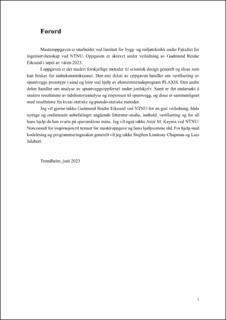| dc.description.abstract | Jordskjelv er et svært komplisert naturfenomen som kan føre til konstruksjonskollaps og redusering av stabilitet til støttekonstruksjoner. Pålitelig prosjektering med hensyn til dynamisk belastning kan minke fare for store skader og tap.
Denne oppgaven tar for seg et mål å gi en oversikt av eksisterende metoder til seismisk design med fokus på kvasi-statiske, pseudo-statiske, empiriske og numeriske metoder, som kan anvendes til prosjektering av spuntvegger av stål. Dessuten handler oppgaven om viktige begreper for dynamisk analyse, dynamiske jordparametere og presenterer grunnleggende geotekniske antagelser og teorier.
Deretter gis det en kort innledning til small-strain teori og dens anvendelse i beskrivelse av jordas oppførsel. Det skapes et grunnlag for videre fordypning i typer jordmodeller, som er tilgjengelige i PLAXIS 2D for å analysere konstruksjons oppførsel under forskjellige påvirkninger. Det diskuteres hvordan PLAXIS 2D kan brukes til å modellere seismisk påvirkning, vurdere stabilitet, deformasjoner og forskyvninger av støttevegger i forskjellige jordarter.
Videre går oppgaven til verifisering av en foreslått oppbygning av forankret spuntvegg. Etter nødvendige justeringer av systemgeometrien, bestemmelse om materialegenskaper til spuntvegg og anker, beregning av aktivt og passivt jordtrykk fortsetter oppgaven med praktisk anvendelse av PLAXIS 2D. Det beskrives to hovedmodeller med forskjellige grunnvannsnivåer og jordartsfordeling for å få en stor analysebase. Det gjennomføres tre forskjellige jordskjelvs simuleringer ved hjelp av PLAXIS 2D til hver modell for å få et bredt bilde av jord- og spuntveggs respons til påført dynamisk last.
Deretter analyseres resultater av håndberegninger som bygges på forenklede analytiske metoder og anbefalinger til prosjektering i Eurocode 8 (NS-EN 1998-1:2004+A1:2013+NA:2014). Det legges vekt på krefter og moment som spuntveggen bør være i stand til å holde, mulige forskyvninger, forskjell av disse og utbredelse av akselerasjon og deformasjoner ved tid.
Avslutningsvis oppsummerer oppgaven oppnådde resultater, vurderer mulige grunner til avvik, konkluderer om potensial av forenklede analytiske metoder til seismisk design av forankrete spuntvegger og gir noen anbefalinger til videre arbeid og forbedring. | |
| dc.description.abstract | An earthquake is a complex natural phenomenon that can lead to the collapse of structures and the reduction of stability in support structures. Reliable design considering dynamic loading can reduce the risk of significant damage and loss of life.
This study aims to provide an overview of existing methods for seismic design, focusing on quasi-static, pseudo-static, empirical, and numerical methods, which can be applied to the design of steel sheet pile walls. Along the way, the study addresses important concepts for dynamic analysis, dynamic parameters of soil, and presents fundamental geotechnical assumptions and theories.
Next, a brief introduction to small-strain theory and its application in describing soil behavior is provided. This lays the foundation for further exploration of different types of soil models available in PLAXIS 2D to analyze the behavior of constructions under various influences. The study discusses how PLAXIS 2D can be used to model seismic impact, assess stability, deformations, and displacements of sheet pile walls in different soil types.
Furthermore, the study proceeds with the verification of a proposed construction of an anchored sheet pile wall. After necessary adjustments to the system's geometry, determination of material properties for the sheet pile and anchors, calculation of active and passive earth pressure, the study continues with the practical application of PLAXIS 2D. Two main models with different groundwater levels and soil distributions are described to provide a broad basis for analysis. Three different seismic simulations are conducted using PLAXIS 2D for each model to obtain a comprehensive understanding of the soil and sheet pile wall response to applied dynamic loads.
Subsequently, the study analyzes the results of manual calculations based on simplified analytical methods and recommendations for design in Eurocode 8 (NS-EN 1998-1:2004+A1:2013+NA:2014). Emphasis is placed on the forces and moments that the sheet pile wall should be able to withstand, potential displacements, differences between them, and the extent of acceleration and deformations over time.
In conclusion, the study summarizes the achieved results, discusses possible reasons for discrepancies, draws conclusions about the potential of simplified analytical methods for seismic design of anchored sheet pile walls, and provides recommendations for further work and improvement. | |
